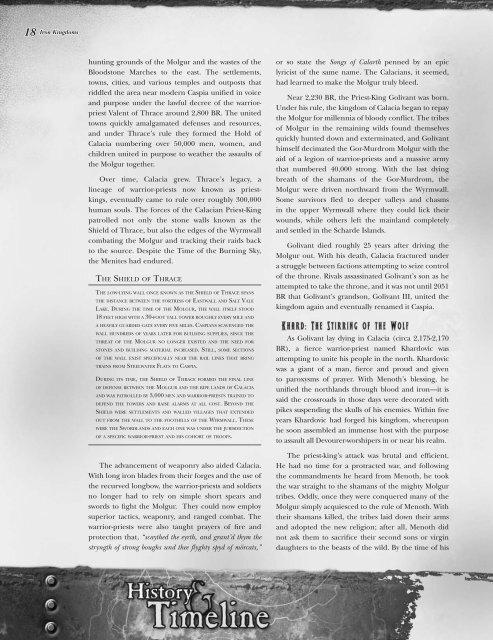02 - Iron Kingdoms W.. - Captain Spud Is Amazing
02 - Iron Kingdoms W.. - Captain Spud Is Amazing
02 - Iron Kingdoms W.. - Captain Spud Is Amazing
Create successful ePaper yourself
Turn your PDF publications into a flip-book with our unique Google optimized e-Paper software.
108.1.141.197<br />
18 <strong>Iron</strong> <strong>Kingdoms</strong><br />
hunting grounds of the Molgur and the wastes of the<br />
Bloodstone Marches to the east. The settlements,<br />
towns, cities, and various temples and outposts that<br />
riddled the area near modern Caspia unified in voice<br />
and purpose under the lawful decree of the warriorpriest<br />
Valent of Thrace around 2,800 BR. The united<br />
towns quickly amalgamated defenses and resources,<br />
and under Thrace’s rule they formed the Hold of<br />
Calacia numbering over 50,000 men, women, and<br />
children united in purpose to weather the assaults of<br />
the Molgur together.<br />
Over time, Calacia grew. Thrace’s legacy, a<br />
lineage of warrior-priests now known as priestkings,<br />
eventually came to rule over roughly 300,000<br />
human souls. The forces of the Calacian Priest-King<br />
patrolled not only the stone walls known as the<br />
Shield of Thrace, but also the edges of the Wyrmwall<br />
combating the Molgur and tracking their raids back<br />
to the source. Despite the Time of the Burning Sky,<br />
the Menites had endured.<br />
The shield of Thrace<br />
The low-lying wall once known as The shield of Thrace sPans<br />
The disTance beTween The forTress of easTwall and salT vale<br />
lake. during The Time of The molgur, The wall iTself sTood<br />
18 feeT high wiTh a 30-fooT Tall Tower roughly every mile and<br />
a heavily guarded gaTe every five miles. casPians scavenged The<br />
wall hundreds of years laTer for building suPPlies, since The<br />
ThreaT of The molgur no longer exisTed and The need for<br />
sTones and building maTerial increased. sTill, some secTions<br />
of The wall exisT sPecifically near The rail lines ThaT bring<br />
Trains from sTeelwaTer flaTs To casPia.<br />
during iTs Time, The shield of Thrace formed The final line<br />
of defense beTween The molgur and The riPe lands of calacia<br />
and was PaTrolled by 3,000 men and warrior-PriesTs Trained To<br />
defend The Towers and raise alarms aT all cosT. beyond The<br />
shield were seTTlemenTs and walled villages ThaT exTended<br />
ouT from The wall To The fooThills of The wyrmwall. These<br />
were The swordlands and each one was under The jurisdicTion<br />
of a sPecific warrior-PriesT and his cohorT of TrooPs.<br />
The advancement of weaponry also aided Calacia.<br />
With long iron blades from their forges and the use of<br />
the recurved longbow, the warrior-priests and soldiers<br />
no longer had to rely on simple short spears and<br />
swords to fight the Molgur. They could now employ<br />
superior tactics, weaponry, and ranged combat. The<br />
warrior-priests were also taught prayers of fire and<br />
protection that, “scaythed the eyrth, and grant’d thym the<br />
stryngth of strong boughs und thee flyghty spyd of mörcats,”<br />
or so state the Songs of Calarth penned by an epic<br />
lyricist of the same name. The Calacians, it seemed,<br />
had learned to make the Molgur truly bleed.<br />
Near 2,230 BR, the Priest-King Golivant was born.<br />
Under his rule, the kingdom of Calacia began to repay<br />
the Molgur for millennia of bloody conflict. The tribes<br />
of Molgur in the remaining wilds found themselves<br />
quickly hunted down and exterminated, and Golivant<br />
himself decimated the Gor-Murdrom Molgur with the<br />
aid of a legion of warrior-priests and a massive army<br />
that numbered 40,000 strong. With the last dying<br />
breath of the shamans of the Gor-Murdrom, the<br />
Molgur were driven northward from the Wyrmwall.<br />
Some survivors fled to deeper valleys and chasms<br />
in the upper Wyrmwall where they could lick their<br />
wounds, while others left the mainland completely<br />
and settled in the Scharde <strong>Is</strong>lands.<br />
Golivant died roughly 25 years after driving the<br />
Molgur out. With his death, Calacia fractured under<br />
a struggle between factions attempting to seize control<br />
of the throne. Rivals assassinated Golivant’s son as he<br />
attempted to take the throne, and it was not until 2051<br />
BR that Golivant’s grandson, Golivant III, united the<br />
kingdom again and eventually renamed it Caspia.<br />
Khard: The Stirring of the Wolf<br />
As Golivant lay dying in Calacia (circa 2,175-2,170<br />
BR), a fierce warrior-priest named Khardovic was<br />
attempting to unite his people in the north. Khardovic<br />
was a giant of a man, fierce and proud and given<br />
to paroxysms of prayer. With Menoth’s blessing, he<br />
unified the northlands through blood and iron—it is<br />
said the crossroads in those days were decorated with<br />
pikes suspending the skulls of his enemies. Within five<br />
years Khardovic had forged his kingdom, whereupon<br />
he soon assembled an immense host with the purpose<br />
to assault all Devourer-worshipers in or near his realm.<br />
The priest-king’s attack was brutal and efficient.<br />
He had no time for a protracted war, and following<br />
the commandments he heard from Menoth, he took<br />
the war straight to the shamans of the mighty Molgur<br />
tribes. Oddly, once they were conquered many of the<br />
Molgur simply acquiesced to the rule of Menoth. With<br />
their shamans killed, the tribes laid down their arms<br />
and adopted the new religion; after all, Menoth did<br />
not ask them to sacrifice their second sons or virgin<br />
daughters to the beasts of the wild. By the time of his


